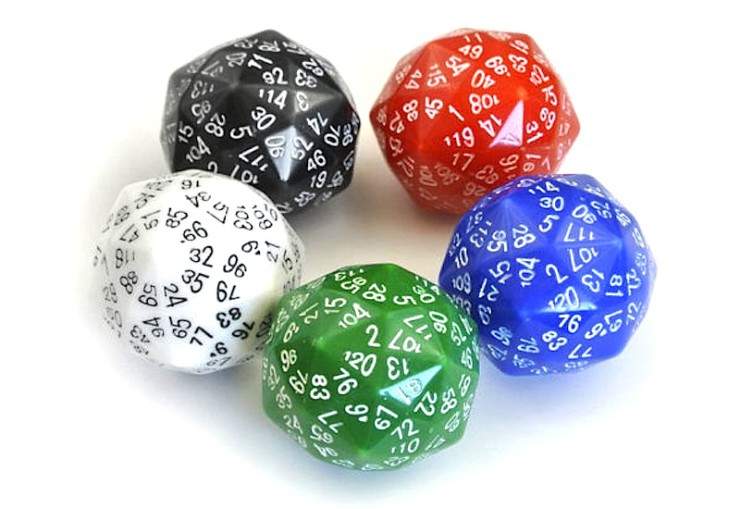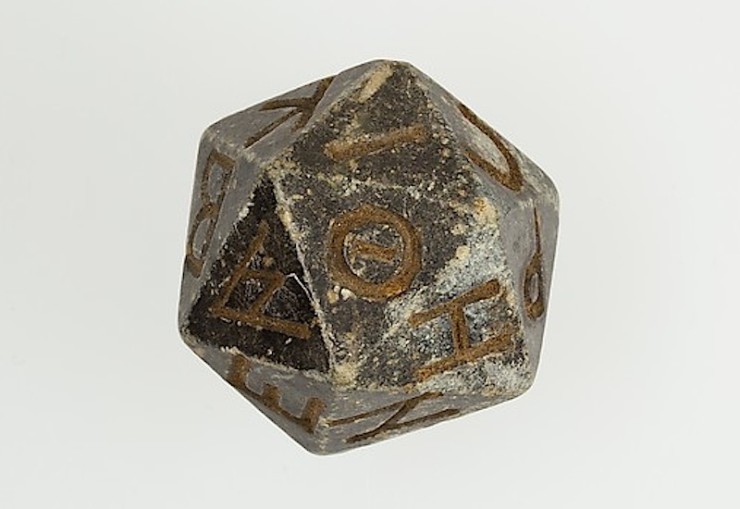Over one hundred and fifty years ago, a French-Belgian mathematician named Eugène Catalan worked out the design for the disdyakis triacontahedron – a 120-sided die. Theoretically it was the most mathematically fair die that could exist. Now, we are pleased to report that we live in a world in which the disdyakis triacontahedron can thunder across gaming boards, thrilling all who watch with its many sides. The New Yorker profiled the creators of the D120, Robert Fathauer, Henry Segerman, and Robert Bosch, and you can read more about them, and check out the die in action, below!
Robert Fathauer, an artist who has a background working on experimental physics for JPL, and Henry Segerman, an Oklahoma State University math professor who specializes in geometry and topology, combine their mathematical powers to create The Dice Lab. Together they design and sell dice with the intention of crating dice that are aesthetically pleasing as they are functional. The D120 has the largest number of faces possible on a mathematically fair die, and presented a rare challenge, as all of these faces needed to add up to 121. As Segerman says, “You can’t go any bigger.” Robert Bosch, an Oberlin professor, came onboard to work out the precise designs needed for the die to roll correctly despite its shape and heft.
“Polyhedra terminology is a somewhat painful matter, to expert and novice alike,” George Hart, a mathematical sculptor and research professor at Stony Brook University, notes on his Web site. Hart, who attended the d120’s première, also found the die’s form aesthetically lacking. “It’s not one of the most beautiful polyhedra,” he told me. “It’s just a little lumpy. It doesn’t have personality.” All the same, he now owns one of the inaugural batch of forty, a present from a friend. As he threw the die around while we talked, he wondered about its fairness, noting that small manufacturing variations might throw off the symmetry and make a big difference in how often any given face lands up. “No one would notice unless they rolled it thousands of times,” Hart said.
The New Yorker profile gives a brief history of dice, taking readers from the dice games painted on Greek amphorae up to sixteenth century French fortune-tellers, with a brief stop to mention this beauty, from 2nd Century B.C.E. Egypt:
The article’s true focus comes in when it outlines Robert Bosch’s efforts to compute the die’s vertices so that each opposing side adds up to one hundred and twenty-one. Bosch spent almost two months running codes to try to get all the pairings to sync; without that, the die would fail. He had two left when he nearly gave up, but in true saving throw style, he ran one last ditch script. When his computer stopped, it either meant that his code had crashed everything, or the Dice Lab could start production. Discovering that the D120 was a go, Bosch said, “It was a great feeling. And it was kind of ridiculous how good a feeling it was, because it’s not practical. It’s just a cool object, a beautiful object. I really love it, but it’s not Earth-changing.”
You can see the D120 in action in this video below, check out The Dice Lab to order your own, and read the full profile over at The New Yorker!











